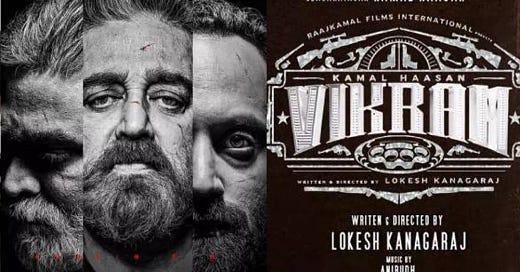My First Tamil Film: Vikram (2022)
An Action thriller by Kamal Haasan, a versatile actor.An Action thriller by Kamal Haasan, a versatile actor.
Disclaimer: Spoilers are included. Please consider the following to be an uninformed review written by someone who is ignorant of Tamil cinema and who saw the movie on the recommendation of a friend in Chennai.
The true goal of a movie is to evoke the necessary emotions in the viewer, and the movie succeeds in doing so. I'm not sure how to evaluate movies using the same standards as other reviewers.
The kidnapping of the main character and the introduction of the context of the case that the investigating agency was pursuing—a case of a serial killer—marks the beginning of the film. The account of Amar, who served as an undercover spy for the assigned mission, sounded entertaining yet uninspiring.
The formation of this entire rebellious and immoral crew acting as government sleeper cells outside the reach of the legal system appears to have been inspired by recent custodial deaths that occurred in Tamil Nadu.
The film's plot revolves around the enigmatic events involving the presumed assailant (kidnapper) and the protagonist, who is missing and presumed dead following the post-kidnapping grenade explosion. The story behind the murderer is revealed in the film, keeping the audience interested. The economic side of the narrative is provided by the disappearance of drug trafficking containers around Chennai.
Why common labourers portray these villains with a distinctive appearance that makes them stick out even in a herd baffles me. The third protagonist is introduced in a very violent manner, but I didn't understand why he was suffering.
Although the slaying scenes were graphic and gruesome, the sword appeared blood-free (a child in me wondered). The protagonist is depicted with a variety of personalities, which makes the character interesting, but towards the middle of the movie, my interest wavered. I waited a few minutes to see if Amar followed up on specific case leads. The movie was too long with a 170-minute watch time, so I started watching it twice as fast.
Amar is after the team of serial killers, and one of their members turns out to be a special investigation officer. He is portrayed as a villain who seeks vigilante revenge after drug traffickers killed his wife and child. They use sayings like "One man's terrorism is one man's revolution" to support their claims. I thought the villains were overly archaic and unaware of contemporary issues; I imagine even today's drug dealers would find their portrayals amusing. I believe the screenwriter ought to have talked to some detectives looking into these incidents.
However, the serial killer and his group are portrayed as extremely vicious with contemporary weaponry, modulated voice, and RF transmitter bugs.
When the protagonist is revealed to be alive halfway through the film, the attention is immediately drawn to Sandhanam's violent war scenes. But I never understood what happened to the guns that they used to enter the marriage hall in the first place. Suspend your disbelief when watching the movie.
The film gives a brief history of Vikram, a member of a secret organisation that the government created and then disbanded. The screenwriter should have done more research on how agencies are established because they are not frequently started with the wide intention of battling antisocial elements.
Hasan's speech with his purportedly radical views on a drug-free society and his portrayal of militants as soldiers of the future gives into the idealism of the character.
I wasn't prepared for Agent Tina's entrance, and it added a fresh perspective to the film, which had previously been dominated by male performers. She used a harsher approach than Sandhanam. It was unexpected that a Macbook and toothpicks were used to kill someone. The route Amar takes to exact revenge for the loss of his wife provides a justification for the suffering. Still, I was unable to comprehend the structural relationship between the government and illegal drug dealers. The screenwriter might have added the relationship's historical context.
The film introduces the black squad team members at the very end. I watched the movie because of Hasan's feelings while defending his child from the Sadhanam Gang's onslaught.
In the era of rocket launchers, the usage of canon seemed futile, but it provided the necessary cinematic effect. The final sequence, in which the character Rolex is introduced, may entice viewers to watch the film's sequel. The way they depict the disarray of the Jungle with the disorganised gang men of the Rolex is still fascinating to me.




